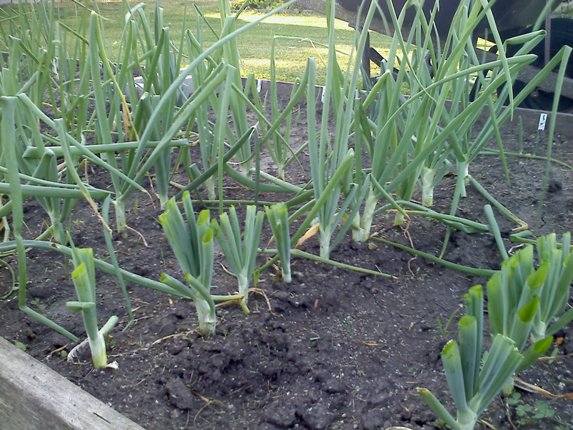
We garden for many reasons. For some of us it’s a calm and soothing endeavor. For others, gardening can be that much needed avenue for getting outside and to feel a part of nature, however small a part it may be. The list can go on and on because for every gardener, there is a story. And for every gardener there are more and more reasons for being such. But at the end of the day, the majority of us garden for one reason: the food. Food grown at home (or even just locally) is fresher and bolder in flavor when compared to its grocery mart counterpart. Plus when you grow your own produce you have the ability to control whether pesticides or harsh chemicals are used during the growing process. These are the kind of things that keep me gardening. But when it comes to taste, one delight from the garden that truly stands out over its store bought rival is the onion.
Growing onions at home is one of the easiest things a gardener can do. All you need is light, well-drained soil and a lot of sun. Onions offer flexibility because they take up very little space. They can be planted along the perimeter of your garden and sometimes in between other plants. All of the different varieties you see in the store are available to grow at home. From the whites to the reds and the spring onions to the Vandalia’s, every delicious variety can be at your finger tips.
First you must determine which method of growing onions is right for you. The life of our onions can begin in a few different ways. Your local greenhouse should carry at least one of the following:
Onion Sets – Dry onion bulbs that are ready to plant.
Onion Seedlings – Tiny, onion plants that are transplanted into your garden. If they are fairly small when you purchase them, you may want to wait a week or so to plant them.
Seed – You can always go the traditional way and start your onion crop straight from seed.
I prefer starting onions from sets (bulbs) because they start growing faster than seeds and the plants appear to start off larger than a young transplant (seedling). Onion sets bought at a retail store usually contain 50 to 100 onion bulbs. So it’s easy to stagger your planting schedule, as long as you store them in a relatively dry place. Before planting, be sure to cultivate your soil. As I stated earlier, onions grow best in light, well-drained soil. If your soil has an abundance of clay, amend it with some kind of organic matter like manure compost. This will help loosen up the soil, allowing more oxygen in and helping it to become less compacted. If your soil is too dense and compacted, the onions won’t get very large. Onions also like nitrogen so, especially if you’re an organic grower, you may want to till nitrogen rich compost into the soil.
Onion sets and transplants should be spaced 4 to 5 inches apart, but what many gardeners do is plant them with 1 to 2 inches of space between. They can then thin them and enjoy some green onions simply by picking every other one. When you are starting onions from seed, sow the seeds at the depth that is recommended on the package. It’s usually around ¼ inch deep and then thin them to your liking. Another reason I like starting with the onion bulbs, is that when I do thin out the crop I can simply replant in those spaces, which will give me more delicious green onions. The plants are above the surface within a few days and can be eaten within 3 to 4 weeks, only lightly disturbing the growth of the onions on either side of them.
Okay, so you’ve cultivated the soil, sowed your seeds and now the plants are around a foot tall, your work is done, right? Not quite. Though onions are easy to grow, there are a few things to focus on while caring for your crop. The first is watering; it is important to keep your soil moist and to not let it dry out for too long. But, and here’s the important part, you must be sure to not saturate them completely. If the soil stays to wet for too long, onions will rot in the ground. If this happens you will be able to feel it in the bottom part of the stem, just above the soil. It will feel extremely soft and spongy. If you catch this right away, allow the soil to dry out completely before watering again. Though the top may be a bit rotted the remainder of the onion may still be okay. Also, make sure to be vigilant when it comes to the weeding. The roots of the weeds share the same space as the roots of the onions and nutrients that are by the onion will be taken in by the surrounding weeds. So be sure to remove any weeds on a regular basis.
A Trick for Larger Bulbs and Better Taste
As your onions grow larger, they will begin to form flowers that will eventually bear seeds. When the plant enters this stage it may begin to slow the growth of the onion bulb and possibly slightly affect its taste. A trick I like to use is to cut the tops of the leaves off when the flower begins to form. This will keep the plant in its normal growing stage while, at the same time, directing more nutrients to the growing onion. The flower will continue to grow back, when it does just cut it off again.
Harvesting
Onions can be harvested at any time during the growing season. If you want them to grow to their full potential and plan on saving them in a root cellar or refrigerator, here are some tips to help you along. The best way to tell if your onions are done growing is to watch the leaves. When the leaves are done helping supply the energy needed to grow the onion, they will stop growing, turn brown and fall over. It will look like the plant is dead but don’t worry; it’s the natural progression. After the tops have turned brown and droopy let the onion sit for 7 to 10 days in the soil to finish growing. When harvesting, it helps to use a small garden spade to dig them out because the top growth will be weak and brittle by this point. Let them dry in the sun for a day or two to remove any excess moisture. After they are dry, you can cut the top growth off one inch above the bulb and remove all the roots. Leave the bulbs in a warm, dry and airy place, like a porch or a garage for two to three weeks to complete the drying process. When the onions are ready for storage, the outer shell will be crispy. Store them in a cool, dark, dry place and enjoy for months to come.
Kyle Ladenburger is an avid indoor and outdoor gardener.



Comment here